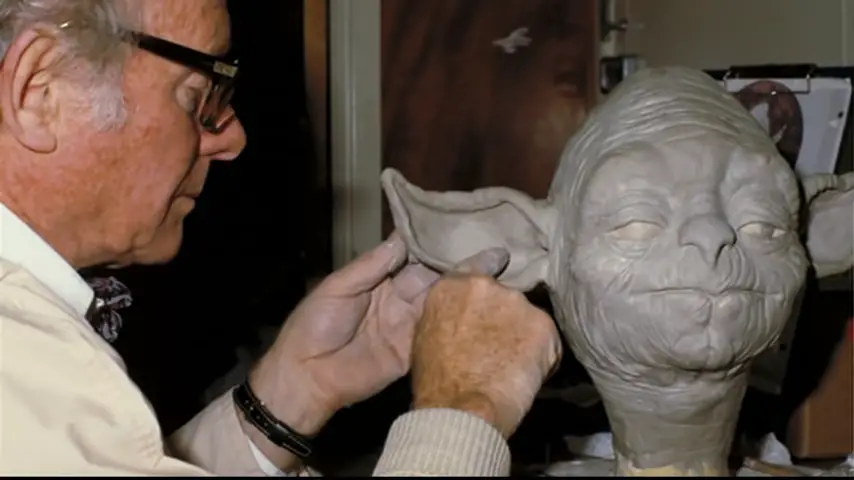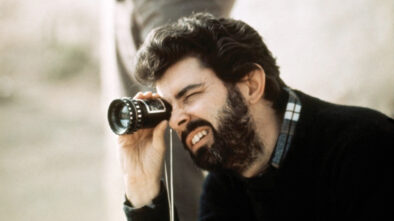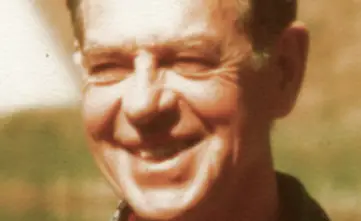Stuart Freeborn Based Yoda On His Own Facial Features
Take a detailed look into the creation of Yoda by the ‘grandfather of modern make-up design’, Stuart Freeborn
This is the first in a detailed series that looks into the creation and evolution of Yoda in the Skywalker Saga. He’s undergone quite a few changes as technology has improved. Here we start at the beginning, with a puppet operated by Frank Oz in The Empire Strikes Back, which remains the gold standard for Yoda today. Even advances in CG during the Prequel Trilogy could not match the nuances and subtle expressions and movements created by Stuart Freeborn’s greatest achievement: Yoda.
Today, it’s difficult to imagine just how much of Empire’s success hinged on making a realistic-looking diminutive, 2-foot, weird-looking, green puppet. But Lucas wanted to push the boundaries of creature design in Empire. He had been frustrated with doing Mos Eisley’s cantina sequence on the cheap in the first film. In 1980 he got his chance to rectify this with the sequel. But he knew the risk:
“If it had not worked, the whole film would have been down the tubes, It just would have been a disaster of a movie. If it had been a silly, little Muppet it would have been Kermit riding around in that movie. The whole movie would have collapsed under the weight of it.”
Lucas and director, Irvin Kershner turned to Stuart Freeborn, the makeup supervisor and a special effects artist on Empire.
Early Concept Art
When Freeborn took control of the design of Yoda, a variety of concept designs existed of the Jedi master, including from production illustrator Ralph McQuarrie and concept artist Joe Johnston. According to Nick Maley, a make-up artist who worked for Freeborn on A New Hope and Empire, early concepts of Yoda “looked like a cross between Yoda and Jimminy Cricket … [T]he proportion of Jimminy with Yoda’s round face and pointy ears. He seemed younger and rather impish.”
When Freeborn took control of Yoda, he retained the long pointy ears present in a number of those early designs. At least the idea of them. However, for the most part he went back to the drawing board, or more accurately, a lump of clay.

Early designs of Yoda.
Sculpting His Own Likeness Into The Clay Model
Freeborn started with a lump of clay, and used Ralph McQuarrie’s design as a starting point. But before he began molding clay, Freeborn cast Frank Oz’s arm. The length and breadth of Oz’s arm would have an impact on Yoda’s final proportions. Still, Freeborn spent months trying to reduce McQuarrie’s design into a 28″ puppet. During that time Yoda went through a number of changes. Lucas, and producer, Gary Kurtz, would come in periodically and discuss Freeborn’s work, and then Freeborn would work on the clay mold for another week. And then the whole process would start again.
Freeborn was under the gun. Working to a tight schedule meant that the longer he took to get the design of Yoda’s mold right, the less time he had to build the actual puppet. At one stage Freeborn had three or four different versions sitting side-by-side!
The breakthrough came when Freeborn decided to put his own likeness into the design.
“… I looked in the mirror and thought, ‘Well perhaps there’s something a bit amusing about my face.’ So I modeled something of myself. Now I’ve to make him look intelligent.”


Stuart Freeborn incorporated his features into Yoda.
…With A Touch Of Albert Einstein
Freeborn was inspired by a photograph of Albert Einstein hanging on his office wall. Einstein seemed like a perfect fit for the bog-dwelling sage of Dagobah. He proceeded to incorporate Einstein’s eyes and wrinkles into the design.
“A picture of Einstein ended up on the wall behind the Yoda sculptures and the wrinkles around Einstein’s eyes somehow got worked into the Yoda design,” said Maley. “Over the course of this evolutionary process, Yoda slowly changed from a comparatively spritely [sic], tall, skinny, grasshopper kind of character into the old wise spirited gnome that we all know today.”
At this stage, Oz asked that the puppet have no jaw fitted.
“That allowed him more freedom for expression as a puppeteer,” added Maley. “[B]ut it also meant that the skin hung loosely below the cheeks and that gave Yoda an older, rather chinless look that is quite different to the drawings Ralph did.”
“I did a lot of thinking about it because he’s got to be full of subtle action and movement especially in the face and the body,” recalled Freeborn. “And I put it all in. What was necessary. And finally it all worked.”

Creating the Mold
Maley’s job was to turn Freeborn’s finished model into molds. The process was “nerve-wracking” requiring the use of Crystocal Gypsum which destroyed the model, and thus left no maquette.
“…[I]f we messed up, all that work was down the drain,” said Maley. “Stu was pretty nervous about it and couldn’t resist double checking the molding of the face as it proceeded. The model had to be dissected to be molded and there were quite a few molds required to make the various parts that were needed to convert the clay sculpture into a working puppet.”
Maley first constructed a three part skin mold, which produced a foam latex skin. Then he created a second mold from the plunger of the first mold and the cast of Frank Oz’s arm. Finally, Maley molded the ears, hands and feet.
From the second mold, Yoda’s fiber glass and polyurethane cranium was constructed. It all had to work together: the latex skin covering the skull, and all of it fitting nicely as a glove puppet for Oz’s hand and arm. Thus, the size of the cranium needed to be the difference between the inside of the latex skin and the exterior of Oz’s hand.
“The accuracy of all these molds was critical if we wanted to put the parts back together again,” he said. “Apart from needing to satisfactorily impart the details of the modeling and produce minimal distortion where the parts of the mold meet, the interior or the skin must be an accurate likeness of the skull and the plunger must locate perfectly around the eyes.”
The Difficulties of Foam Latex Skin
Maley made the foam latex skin, while plasters were constructing Yoda’s skull. Creating foam latex skin is a complex process in itself. It had to be of varied thickness. For instance, the skin around the eyes is less thick to most other areas.
Alongside thickness is also density. “We made skins of varying densities to find the right balance between resilience and resistance and expanded the shrunken foam (8%) back to it’s original size using Diisooctyl pthalate suspended in alcohol.”
Building Yoda’s Torso, Arms, and Legs
Maley’s colleague, Wendy Midener, who also helped Oz operate Yoda, constructed the Jedi Master’s torso from 1″ sheet of polyurethane, following a design similar to the construction of the Muppets. The design cleverly created body shape without being too heavy, and was hollow while being hard-wearing.
Arms and legs were detachable. Many versions existed with each used for specific shots. Some were mounted to rods, while operators wore others like gloves.
- Heart of Stone: Female Bond-Clone References Moonraker, On Her Majesty’s Secret Service and Other Bond Films - February 8, 2024
- How Editor Peter Hunt Saved ‘From Russia With Love’ - January 27, 2024
- This Periodic Table of Tropes Is The Ultimate Storytelling Infographic - January 22, 2024




